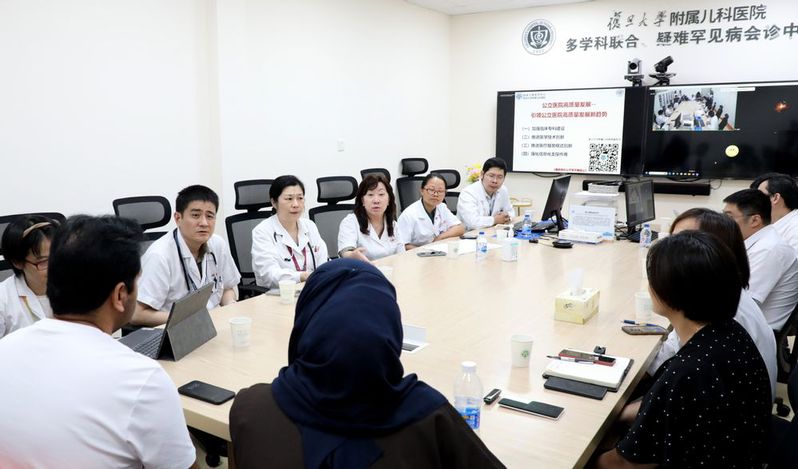On October 8, in the Hematology Department of Children’s Hospital of Fudan University, a Pakistani couple witnessed a lifesaving miracle for their 2-year-old daughter: after three months of seeking cross-border healthcare, their 2-year-old daughter received a transplant of her newborn sibling’s umbilical cord blood stem cells, marking a crucial turning point in her fight against a rare and fatal neurological disorder.

Desperate Search for a Cure
Anna (pseudonym), a 2-year-old girl from Pakistan, had been living with her parents in Saudi Arabia when symptoms first appeared. At 18 months, her parents noticed that she frequently stumbled while walking and had difficulty grasping objects. Additionally, she also showed signs of strabismus (crossed eyes).
After a series of tests (including an MRI and genetic screenings), Anna was diagnosed with a rare hereditary neuro-metabolic disorder: Metachromatic leukodystrophy (MLD). Doctors in Saudi Arabia warned Anna’s parents that children with the disorder will progressively suffer neurological damage, and the disease is fatal without any intervention.
Desperate to find treatment, Anna’s parents explored every possible option but failed to find an effective solution from local healthcare facilities and even in UK.
With the help of a business partner in China, the Pakistani couple discovered that Children’s Hospital of Fudan University in Shanghai might offer a treatment for such disorders through stem cell transplantation.
While MLD, as a genetic disorder, primarily affects the nervous system, allogeneic hematopoietic cell transplantation(allo-HCT) can effectively correct the metabolic abnormalities caused by the genetic defect, halting the progression of the neurological damage.
Fudan’s pediatric transplant team was one of the pioneers in China to provide such treatment. In 2022, they already published China’s first clinical study on this procedure in an international medical journal.
After consulting ZHOU Shuizhen, a neurology expert at the hospital, Anna’s parents, with a renewed sense of hope, immediately established contact with Children’s Hospital of Fudan University through its international healthcare services. With 39 similar cases treated by the hospital, the prospect of a cure for their daughter was now within reach.
An Innovative Treatment Plan
On July 11, after gathering all of Anna’s medical records, the hospital immediately arranged a comprehensive online multidisciplinary consultation with specialists from neurology, clinical genetics, hematology and other departments.
During the consultation, the experts noticed that Anna’s mother, who was pregnant at the time, might provide a new solution to the situation.

After careful analysis, they proposed a bold treatment plan: the newborn’s umbilical cord blood, if proved compatible, could serve as a source of stem cells for Anna’s treatment. In pursuit of this promising approach, a collaborative effort was initiated, with the expertise of doctors from the Obstetrics & Gynecology Hospital of Fudan University joining the quest to preserve Anna’s life.
Luckily, the genetic and transplantation compatibility test results confirmed that the newborn’s umbilical cord blood stem cells were a perfect match for Anna.
Therefore, on September 11, when Anna’s baby sibling was born at Obstetrics & Gynecology Hospital of Fudan University, the umbilical cord blood was promptly transported to the Cord Blood Bank, preparing for the following transplantation.
On the morning of October 8, the life-saving stem cells started to be infused into Anna’s body. This moment was the culmination of months of tireless work of Fudan’s medical experts, and the unwavering faith of Anna’s parents.
With the cutting-edge expertise of stem cell transplantation, Children’s Hospital of Fudan University has given Anna and her Pakistani family, along with countless other children and families globally who were once confronted with incurable diseases, a renewed opportunity for life.
(END)
Presented by Fudan University Media Center
Writer: HU Chenxin
Editor: WANG Jingyang, WANG Mengqi, LI Yijie


